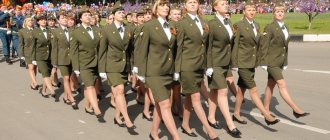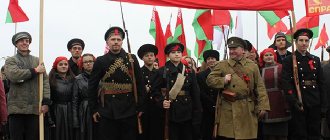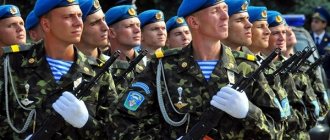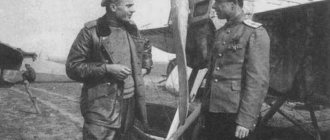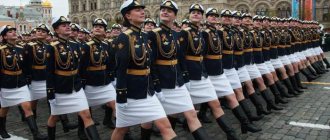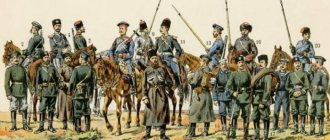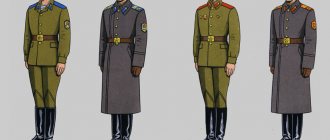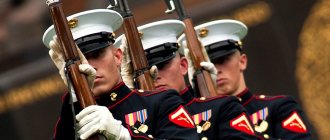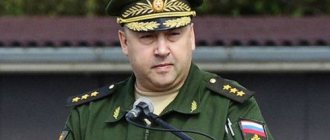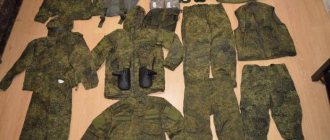Every man, especially those who served, will agree that military clothing is considered the key to the high combat effectiveness of military forces. In Russia, military uniforms always meet all the necessary requirements: they are reliable, comfortable and perform all their main functions. Today in Russia every soldier of the military forces is equipped with a military uniform. Still, uniforms are one of the important aspects of service.
Let's consider what a uniform is, why it is so important for a military man, why it is considered a symbol of honor.
Dream Interpretation – Military, military actions and exercises, military camp
If the sleeper sees in a dream that he must take part in some kind of military action, then most likely he will have a lot of trouble due to some kind of trouble. For single men, such a dream predicts that he will soon have to go to military exercises. Seeing the military in a dream is a sign that your worries are in vain and you will be overcome by boredom. Seeing an officer in a dream is a harbinger of the fact that you will be forced to do something unpleasant... Seeing a general in a dream is a sign of patronage, if only he is disposed towards you. See interpretation: important person. Seeing yourself in military uniform means there is a family scandal or trouble at work. For a patient, a dream that he has become a military man predicts imminent death. Seeing a military divorce is a sign of a waste of time and money. Seeing a sentry at your post means that you will soon receive news that some influential people are interested in promoting your business. Watching military exercises portends success in business. For a woman to find herself in a military camp in a dream is a harbinger of an imminent engagement to a civilian, and for a young man such a dream predicts a love affair with the wife of a man who is on military exercises. Seeing military exercises in a dream means worries and squabbles; taking part in them yourself is a shame. For a girl to dream that her lover is going into the army, it means that she will soon get married, but will be widowed early. For a young man, such a dream predicts a profitable business or a good job. For patients, a dream about military conscription predicts an imminent death. For employees, such a dream predicts that they will have a lot of work, and for people in a dependent position, the dream predicts an imminent release from guardianship and the coming of a moment when they will become independent and will be able to act at their own discretion.
Redcoats attack
The English army has always had a special attitude towards the color red. British troops became famous during the war for the liberation of the North American colonies. At a time when there was a trend in all the armies of the world towards calmer and less attractive colors in military uniforms, the British army continued to remain the most conservative military institution. The English Redcoats gained fame largely due to the acts of cruelty that English soldiers and officers showed towards the enemy and the civilian population.
The attitude towards the color red in the British army was special. This can be judged by looking at the commitment of the British military to their military uniform. The tendency towards bright colors is explained by the fact that the English army often had to conduct military operations against the native population. The color red was supposed to become a significant factor in the psychological impact on the enemy. In addition, the close range of fire combat practiced in the 17th-19th centuries did not in any way affect the camouflage capabilities of army units on the battlefield. The red color of the military uniforms of the British troops is well remembered by the infantry and militia of George Washington's army. The Indians of Canada, the peoples of Persia and India experienced all the horrors of military operations waged by the English colonial army. French grenadiers and cavalrymen will forever remember the English squares with red rows at the Battle of Waterloo.
For the English army, the red color of the uniform continued to remain unchanged until the end of the 19th century. Only a change in combat tactics and the emergence of powerful and long-range types of hand-held firearms led to the fact that the bright and catchy uniform of English soldiers and cavalrymen began to be used only in ceremonial ceremonies. Rifle and long-range artillery forced the soldiers to bury themselves in the ground. The red color on the battlefield was replaced by khaki.
However, before changing its traditions, the British army was able to demonstrate to the world the courage and valor of its soldiers, dressed in red uniforms. The English hussar uniform was red, becoming over time both a symbol of the highest human stupidity and a symbol of fearlessness.
During the Crimean War, the British, along with the French and Turks, took part in the fighting in the Crimea. In the area of the village of Balaklava, the English light cavalry under the command of Colonel Cardigan was thrown into an attack against Russian artillery. The plan of the attack proposed by Lord Raglan, commander of the English expeditionary forces in Russia, was quite clear. It was necessary to knock out the Russian units from the commanding heights, from which it was convenient to fire on the Allied troops heading towards Sevastopol. The English light brigade consisted of 5 hussar squadrons. The attack plan provided for a surprise attack of two cavalry brigades at once, light and heavy, but it was the light cavalrymen who were sent to the slaughter.
The result of the terrible attack was terrible. The British light cavalry was shot at point-blank range by Russian cannons. More than one hundred red uniforms remained lying on the battlefield. Since then, the attitude towards the red coats on the shores of Foggy Albion began to change. The decline of bright military uniforms on the battlefield was completed by military operations in Southern Africa. During the Anglo-Zulu War, which broke out at the end of the 19th century, the Zulus, supported by Dutch colonial hunters, literally mowed down British soldiers during sniper fire with bows and rifles. The red uniform of English soldiers made an excellent target.
Advantages of the new uniform of the Russian Army
Modern field uniforms for soldiers and officers are highly comfortable due to multi-layering (8 levels). In its production, membrane materials and other latest technologies are used, and special treatment of the seams is done. The kit contains a large number of items that are used depending on weather conditions and surroundings.
Basic levels of military uniform, rules for its configuration:
- 2 types of underwear (underwear and fleece for thermal insulation during the cold period);
- jackets (levels 3-4) - fleece for insulation and a windbreaker for cool weather;
- Soft Shell suit (5th), made of waterproof and windproof fabric with increased breathability, used as protective outerwear;
- windproof suit (6th), made of membrane material with “breathable” properties with numerous fasteners and zippers;
- insulated suit (level 7) - designed to protect against extreme cold conditions;
- a summer field suit made of cotton is worn in the outer layer in the summer;
- The period of wearing a military field uniform issued to military personnel is 3 years.
In 2016, 4 thousand sets were sewn for military personnel who serve in difficult northern conditions and in the Arctic. Such equipment is designed to protect a person from prolonged exposure to cold in strong winds and high humidity, during rain or snow.
Uniform in the army of Catherine and other Russian tsars
During Catherine's reign, Prince Potemkin first raised the question of convenience for soldiers and officers when wearing military uniforms. The tradition of wearing wigs was abolished, and uniforms were replaced with more practical and wide ones; trousers began to be tucked into boots. Soldiers wore helmets on their heads to protect them from saber strikes.
With Paul coming to power, the uncomfortable uniform returned to the army, as did the wearing of wigs and uncomfortable patent leather shoes (which chafed their feet). Moreover, for non-compliance with this form, people could be exiled to Siberia.
Under Alexander II, Russian military uniforms were restored to their aesthetic appearance and comfort. The more spacious cut made it possible to wear warm underwear, which was a salvation for soldiers in the cold winter months. Military overcoats were introduced into use, with a warm cap on top. The cut was chosen to be simpler, so in appearance the Russian military uniform began to resemble peasant clothing. Its production was cheaper, and in order to save money, the king issued a decree that money for uniforms was deducted from the salaries of soldiers and officers.
At the beginning of the 20th century, after the Russo-Japanese War, single-breasted tunics with a stand-up collar were introduced into the uniform set of the Russian military; the color chosen was protective green, the fastener was made with 5 buttons, and pockets were added. Having become popular, this style was called “French” in honor of the British general.
Form after the revolution
After 1917, during the Civil War, the uniform of the Red Army was not unified: the only distinctive feature was a scarlet ribbon with the inscription “Red Guard”, which was worn on a sleeve or hat. In 1918, an original cloth headdress appeared, which was later called “Budenovka” (at first it was called “heroka”). Shoulder straps were abolished, replaced by distinctive squares and triangles that could be used to identify rank and troops.
The wearing of the emblem in the form of a red star was approved in May 1918, which became a symbol of the young state. It was worn on an overcoat, jacket, tunic, etc.
In 1922, a decree of the Revolutionary Military Council was issued on the transition to new regulated uniforms, and the old uniform was canceled
Much attention was paid to insignia, which were sewn onto the sleeve flap, buttonholes and other forms. They differed in color, shape, etc.
d. The basic uniform consisted of a cloth overcoat and helmet, a tunic shirt, riding breeches, boots or boots. The cloth used was dark gray made of wool, the shirt was gray made of dyed cotton fabric.
Red Army uniform
In 1924, the Workers 'and Peasants' Red Army (RKKA) introduced another military uniform, consisting of a tunic with a turn-down collar and pockets, an overcoat, breeches, boots or boots. Instead of a helmet, a khaki cap with a red star was invented. For winter they used short fur coats, jackets made of merino cloth with cotton wool, coats, raincoats, caps and bekeshi (short coat made of sheepskin).
Separately, uniforms were designed for air force troops and pilots. They differed in the color of the cloth, insignia, buttonholes and sleeve insignia. In 1926, Rules for wearing uniforms were introduced and dividing them into summer and winter. In addition, depending on the situation, military uniforms were divided into everyday, guard and marching. The constant wearing of equipment and insignia became a categorical requirement. Camping equipment included: a commander's belt with a buckle, a holster with a pistol, a saber, a field bag, to which a flask, a gas mask, and binoculars were added during the campaign.
For different types of troops, uniforms could differ: for tanks, overalls and leather jackets, helmets, and dust goggles were invented.
At the end of the 1930s and in 1940, the participation of the Red Army in military conflicts also influenced the revision of attitudes towards uniforms. New elements of the winter uniform have appeared: a steel helmet, a hat with ear flaps with fur. Changes were made to the details of the uniform for generals and marshals, new emblems and cap badges appeared on caps separately for each branch of the military, and spurs were added to boots. A warm overcoat with 5 buttons was required.
The next changes to the wartime uniform were introduced in 1943, when a turning point came in the Great Patriotic War: shoulder straps were revived, black and red colors for artillerymen were returned, new uniforms were installed for the Cossacks, and the dress uniform was updated.
Titles, uniforms, orders in the Russian Empire
Shepelev Leonid.”…At the end of the 19th – beginning of the 20th centuries. the intrigue based on the use of the triad “title - uniform - order” was reflected in the works of A. P. Chekhov. There is no need to recall the content of the famous story “Anna on the Neck.” The story “The Triumph of the Winner” depicts “His Excellency” Kozulin, who, having surpassed his former boss Kuritsyn in rank and position, takes humiliating revenge on him for past bullying. In “Fat and Thin,” Chekhov talks about a more typical situation: how the difference in ranks was perceived by those of lower rank, What do all these concepts and terms mean: Privy Councilor, Obershenk, Adjutant General, Excellency, Count, etc. ; white uniform and uniform sewing, “white buttons”, piping, code, key, etc.; ribbons, diamond signs, stars, etc? Even if the reader is familiar with the mentioned titles, uniforms, orders and their accessories, then finding out their real meaning (the rights and obligations associated with each of them) will certainly cause difficulties. Perhaps, direct, conscious ignorance, prompting one to find out, is not as dangerous as the illusion of knowledge, i.e.
erroneous or incomplete knowledge. Accurate knowledge of titles, uniforms and orders that existed in the past is especially important for those who, due to their professional duties, turn to historical research: historians, local historians, archivists, natural historians, art critics, directors and other artists. Very often, such knowledge is important for the very understanding of the research topic and for attributing historical sources: to find out their author or addressee, the identity of the person being portrayed, to establish the approximate date of the document. In all cases, of course, the historian must understand the relevant terms and understand what is hidden behind them, and be able to distinguish the norm from the exception. For a historian, it is necessary to be aware of the significance of a particular title, uniform or order, what rights and responsibilities were associated with them, to whom they could be given, and at what time they existed. In the course of historical research into the biographical genre, knowledge of titles, uniforms and orders naturally acquires particular importance
Meanwhile, in the works of even the most experienced researchers, when referring to titles and uniforms, errors and inaccuracies are made... etc." naval jacket 19th century
Requirements for the uniform
What is a uniform, and what are the requirements for it? Basic requirements:
- uniformity;
- external attractiveness;
- comfortable to wear.
It was quite rare to combine these requirements in one sample. Such uniforms were supposed to indicate their relationship to a particular branch of the military or department, and inform about the rank and position of its owner. In most cases, it could accompany the owner throughout his life, from educational institution to retirement. The uniform could well be seen as a kind of reward; it was seen as a symbol of departmental solidarity and a clear reason for pride.
Glinka V.M. Russian military costume of the 18th-early 20th centuries.
“...In the horse regiments in 1863, caps with a crown in the color of the Circassian coat and a band in the color of the beshmet were introduced. During the first two years of the reign of Alexander III, new uniforms for all troops were introduced, which remained almost unchanged until 1894. Already in July 1881, orders appeared, at first relating only to trifles “in the form of simplification of various forms.” The braided belts of bladed weapons of officers in all army troops were replaced by leather “white yuft”, and all sultans on headdresses were also abolished, except for those assigned to the guards lancers and hussars. The ranks of all army lancers, hussars, Cossacks and those units that had hard caps of the 1873 model were ordered to always wear caps when in marching uniform; In the Uhlan army regiments, colored lapels and epaulettes were abolished for all lower ranks who had them, except for timpani players. The position of drum major, which by this time had remained only in the guards infantry, was abolished, and the white cloth ballroom trousers worn by generals and pages were also abolished. And in November 1881, all army infantry, foot artillery, engineering troops, eighteen army dragoon regiments, the gendarme corps, officials of the War Ministry, the military judicial department, topographers and couriers received a new uniform. It included: a round black merlushka hat (10 cm high) with a cloth flat top, a copper coat of arms, under which artillerymen have an image of cannons, and sappers have axes, a black uniform for lower ranks and a dark green uniform for officers, which was a jacket With a folded side with five hooks without buttons, a collar (4.5 cm high) and a smooth wide back.
The insignia of the military branches were shoulder straps for all, infantrymen and cavalrymen had colored flaps on the front of the collar, and artillerymen and sappers had edgings (edgings) along the upper and lower edges of the collar. The officer's uniform was distinguished by braided or embroidered gold or silver buttonholes on the collar and cuffs. For dress uniforms, it was accompanied by epaulettes and a scarf; for everyday uniforms, it was accompanied by braided shoulder straps and a colored cloth or cashmere sash. The trousers of the infantry soldiers, foot artillery and sappers were black without piping, while those of the officers were dark green with red piping, tucked into high boots for all ranks. The colors of cap bands, uniform collars, flaps on coats and overcoats, the field of officer epaulettes and shoulder straps of lower ranks remained the same as under Alexander II. In dragoon regiments, gendarmes and officials of the War Ministry, departments, military-judicial department and couriers, gray-blue trousers are worn. The length of the uniform from the waist for foot troops is 31 cm, for dragoons and gendarmes - 26 cm...”
Glinka V.M. Russian military costume of the 18th-early 20th century.
Uniform for 1900:
…………………………………..
You can also see documents on uniforms and tunics from 1881 to 1909
| etc.. at the address |
"Sklad" website. or by search engine (now you know the name..)
Book:
Titles, uniforms, orders in the Russian Empire——— • ———Titles and uniforms of officials of the Civil Department——— • ———Uniforms HISTORY:
source
HERE
The brightest and most beautiful military uniforms
Despite the growing popularity of military uniforms among members of civil society, for all their attractiveness, these clothes created a lot of everyday problems. The bright and ornate uniform of the tunics was a trademark. The ceremonial uniform created a lot of inconvenience during movement, not to mention horse riding, which was then mandatory during ceremonial ceremonies.
Hussar uniforms
Outside the ranks and in ordinary situations, uniform etiquette caused a lot of ridicule. Military and service people tried to reduce the time they spent in full dress uniform, preferring ordinary civilian dress or field military uniform to a shiny uniform. A completely different situation developed in that environment where wearing a uniform was mandatory in any situation. A striking example of such an attitude towards military uniform is the hussar’s uniform. It was the hussars who had the brightest and most attractive military uniform. The lifestyle of the hussars, their unspoken code of conduct was inextricably linked with military uniforms. Appearing in Hungary, a country where there was a special attitude towards military uniforms, the hussars brought national flavor to the style of military costume. The appearance of the hussar uniform, lifestyle, manners and behavior on the battlefield made the hussar uniform a household name. Courage, bravado and heroism and a brilliant military uniform were considered the main distinguishing features of the hussars. Thanks to this, the uniform of hussar regiments became popular throughout Europe.
It should not be argued that the military uniforms of other military formations and branches of the military were lackluster. Here it would be appropriate to focus on combat expediency. Marine uniforms become as comfortable and practical as possible. The jackets have straighter contours and cuffs. The military uniforms are distinguished in a similar way . For cavalry units, to some extent, the desire for the pomp of a military uniform remains. The cuirassier units, descendants of the cavalry guards, continued to wear uniforms that were distinguished by elegance and chic. A steel helmet successfully complemented the cuirassier's military suit . A completely different picture is observed among the hussar units. In the armies of leading European powers, hussars always wore military uniforms that differed in color. If for other branches of the military a certain unification of military uniforms was preserved, then with the hussars the situation looked completely different.
Each regiment had an approved military uniform, in which the dolman and mentic had their own, clearly defined colors. Red uniforms become the most common among hussar units. This color is given to military units as a sign of respect for special military merits. In the Russian army, the red dolman and mentik were worn by cavalrymen of the Life Guards Hussar Regiment. The remaining 12 hussar regiments had uniforms of other colors, ranging from black and gray to blue, green and combined colors. Russian hussars always rushed to the most dangerous sectors of the front. The valor and courage shown in battle by the Russian hussar regiments became the reason for the fact that the hussar uniform became a mandatory part of palace etiquette. In civil society, a fashion appears for hussars, who become central figures in all public events.
Red hussar uniform
For example, just look at the uniform of the Russian hussar regiments:
- The Alexandria regiment had a black dolman and mentic;
- The Akhtyrsky regiment wore a brown uniform;
- The Belarusian regiment had a combined uniform - blue red mentic :
- The Grodno regiment dressed in blue dolman and blue mentic;
- The Elizavetgrad regiment wore gray dolman and mentik;
- The Izyum regiment wore a red dolman and a blue mentik;
- The Lubny Hussar Regiment had a blue uniform;
- The Mariupol regiment also had a dolman and a blue mentik;
- The Oviopol Hussar Regiment dressed in green uniforms;
- The Pavlograd regiment wore a green dolman and a blue mentic;
- The Sumy Hussar Regiment dressed in gray uniforms;
- The Irkutsk Hussar Regiment also had a black uniform.
At first glance, we can conclude that the uniform of the hussar regiments was not particularly different. However, in terms of the hussar costume, there were a lot of other elements with which it was possible to make differences in the uniform. This is the color of the fur on the collar and cuffs of the mantle, the color of the instrument metal. The tashka and sash belt could also have different colors and introduced differences into the traditional hussar uniform.
The military uniforms of the hussar regiments in Prussia and Poland had similar colors, where green and gray . The Austrian light cavalry wore a black uniform trimmed with gold, yellow and white colors of the imperial flag.
The Grodno, Lubensky and Mariupol hussars had blue uniforms. The hussar regiments of the French army had a similar range of colors. During the military operations of the Napoleonic era, it was precisely when light cavalry clashed that serious tactical mistakes were often made due to the similarity of military uniforms. Over time, in order to avoid such incidents in the future, hussar regiments in Russia began to have a uniform similar in color to field uniforms. French hussars continued to wear blue and light blue uniforms, combining the colors of the French flag in a combination of dolman and mentic.
Blue uniforms
Fashion constantly dictates its terms and requirements for a military suit. For officers, who were often members of the nobility, it became fashionable to add some striking attributes and details to their military costume. Soldiers have a more discreet uniform that places more emphasis on comfort.
The English hussars deserve a separate discussion, whose military merits became legendary and went down in history as participants in the most desperate, fearless, and at the same time senseless attack.
ORDER with details of tailoring and dimensions of the uniform base
source
Officer's uniform of the Life Guards Sapper Battalion, in which Emperor Alexander II was killed.
1870s From other sources: “... 1. Generals
with a general general's uniform (consisting of the General Staff in the infantry, foot artillery and the Corps of Military Engineers, in the guards cuirassier regiments, cavalry and horse artillery).
A) Urban forms.
a) Dress uniform. Dress uniform with epaulettes. Chakchirs are black with red stripes. Orders with the ribbon of the senior order. Scarf. Helmet with sultan. Infantry style sword. For those in the Guards Cuirassier regiments, a broadsword. For those in the cavalry and horse artillery - a cavalry saber. b) Festive uniform. Dress uniform with epaulettes. Chakchirs are black with red stripes (at balls in the highest presence there are white cloth trousers). Orders without ribbon. Helmet with sultan. Infantry style sword. For those in the Guards Cuirassier regiments, a broadsword. For those in the cavalry and horse artillery - a cavalry saber. c) Sunday uniform (for those present at divorces with ceremonies on Sundays). Vice uniform with epaulettes. Chakchirs are black with red stripes. Orders without ribbon. Helmet with sultan. An infantry type sword. For those in the guards cuirassier regiments - a broadsword. For those in the cavalry and horse artillery - a cavalry saber. d) ordinary uniform. Vice uniform with epaulettes. Gray blue harem pants with red stripes. Orders without ribbon. A helmet without a plume. For those in the Guards Cuirassier regiments - a broadsword. For those in the cavalry and horse artillery - a cavalry saber.
B) Travel form.
Vice uniform with shoulder straps. Gray blue harem pants with red stripes and leggings, or in boots. Orders without ribbon. A helmet without a plume. Infantry saber. For those in the Guards Cuirassier regiments - a broadsword. For those in the cavalry and horse artillery - a cavalry saber. Note: in those cases where in cities it is prescribed to be in full dress, they wear a ribbon and a scarf. …………………………………or:
“...VI. General staff and chief officers of the late 19th century:
General Staff of the Main Directorates, the War Ministry, the Corps of Military Engineers, all adjutants and those serving on special assignments.
A. Urban forms
a) Dress uniform. Uniform, assigned to each, with epaulettes and orders (Generals with ribbons of the senior order). Chakchirs, to whom are assigned, and others - gray-blue trousers. Scarf. A helmet with a sultan. Weapons assigned to each.. Members of the Cossack troops are guided regarding headdresses and weapons by the rules established for wing adjutants. b) Festive uniform. The same as required for a dress uniform, but without a scarf, and generals without ribbons. Members of the Cossack troops wear a sash instead of a scarf. A helmet with a sultan. Weapons assigned to each. c) Sunday uniform (for those present at divorces with a ceremony on Sundays). The same as required for a dress uniform, but without a scarf, and generals without ribbons. Members of the Cossack troops wear a sash instead of a scarf. A helmet with a sultan. Weapons assigned to each. d) The form is ordinary. Uniform with epaulettes and orders. Gray blue bloomers. A helmet without a plume. Weapons assigned to each. Members of the Cossack troops wear a sash.
B. Travel uniform
Uniform with shoulder straps and orders. Gray blue harem pants with boots. (The scarf is worn in the ranks and in cases where generals are ordered to wear ribbons). A helmet without a plume. Weapons assigned to each. Members of the Cossack troops - a hat or hat in a cover (see wing adjutants). Members of the Cossack troops wear a sash. Note: At balls in the highest presence, in festive uniform, adjutants and those serving on special assignments, those serving in regular Guards units, as well as all generals of the General Staff and officers attached to the Guards Corps, wear white cloth trousers...”
Frock coat of an aide-de-camp with the rank of lieutenant
Frock coat of the aide-de-camp of His Imperial Majesty's retinue with the rank of lieutenant with the monogram of Alexander III on the shoulder straps. In 1711, among other positions, a new position appeared in the Russian army - “adjutant wing”. These were especially trusted military personnel, serving under military leaders, and from 1713 also under the emperor, carrying out responsible assignments and monitoring the execution of orders.
History of Russian military clothing
In Ancient Rus' there was practically no uniform for the military, since there were no permanent troops. Until the 17th century, each prince had at his disposal a squad, which was dressed in the usual clothes of that time. However, during an attack or defense of the city, its representatives wore protective armor on top.
The first attempt to create the same military uniform (clothing) was made during the formation of the Streltsy regiments in the 17th century. Then red caftans appeared, more than once painted by Russian artists in works of art (“Streltsy” by S. Ivanov and others). Such clothing was called a colored dress, and its color meant belonging to different regiments. There was also a ceremonial uniform that the archers wore during church holidays: it was supplemented with good-quality boots and a fur hat.
What is a uniform?
The word "uniform" originally comes from the French monture, which translates as "equipment", from the Latin mundus, meaning "outfit". Currently, a uniform is a uniform, the main reflection of the departmental affiliation and status of its owner. This type of uniform has at all times been an important element of national culture, contrasting with “civilian dress.” In the old days, quite often deciding for himself the option of starting a military career, a young man paid great attention to the external attractiveness of one or another type of clothing. The presentation of a uniform to a newcomer was recognized as one of the most important events in the life of an employee. In some cases, it provided a real reason for painting a ceremonial portrait, in which the owner was depicted in full growth and with a detailed display of all the necessary attributes. The gold embroidery of the order and other award insignia transformed the uniform into a work of applied art.
Dream Interpretation - Military
People dressed in some kind of uniform - masks, “departments of anxiety in the kingdom of dreams”. Dressed in military uniform - an attack on you from the outside / anxious readiness of the soul / mobilization of spiritual forces / your excitement and upcoming unrest. Seeing a lot of military people - boredom. Soldier to see - good: protection of your life, honor and property. A sentry - joy. A foot knight - a strong, noble person in your environment / some fear / guardian. An artilleryman - deception. Recruits - bad society / losses. To see an officer - conflict with people, having power. To see senior officers - a conflict with people. A general - trouble / excitement and anxiety caused by overestimating oneself.
Children's military uniform
The uniforms are worn not only by members of the Russian Army, but also by students of cadet corps, Nakhimov and Suvorov schools located on the territory of the Russian Federation. In these educational institutions, boys and girls who have chosen a military profession live and study for several years, so that they can then continue to serve and join the ranks of career officers of the Armed Forces of the Russian Federation. During their studies, they wear children's military uniforms, tailored specifically for this educational institution.
Wearing the uniforms of modern army personnel and the uniforms of soldiers from the Great Patriotic War has become popular among children and their parents in recent years. Stylized costumes for boys and girls are one of the popular attributes of children's matinees, which are held in honor of the celebration of February 23 and May 9, and plays about the war in schools.
On sale you can find historical and modern military suits, sewn according to uniforms of officers and soldiers of the Russian Federation, pilots and sailors, policemen and paratroopers, uniforms from the times of the Great Patriotic War. There are also separate accessories: budenovka, camouflage or red beret, army belt, cap and cap, binoculars.
By choosing a beautiful military uniform for children, parents raise them to be defenders of their state, instill in them a sense of patriotism and love for their country. The boys transform into brave officers and soldiers, ready to defend their homeland, as their great-grandfathers and great-grandmothers once did.
Pre-Petrine era
In Russia until the end of the 17th century. There were almost no permanent troops, so there were no military uniforms. The princes' squads were dressed in the same clothes as civilians, only armor was added.
True, some princes sometimes acquired uniform clothes for their squad, but these were isolated cases.
The government of Tsar Michael in 1631, expecting a war with Poland, sent Colonel Alexander Leslie to Sweden to recruit 5,000 infantry soldiers.
In the 17th century, during the reign of Alexei Mikhailovich, “Regiments of the Foreign Order” were formed - military units formed from “willing” free people, Cossacks, foreigners and others, and later from Danish people modeled on Western European armies.
The first unified military uniform in Rus' can be considered the clothing of the Streltsy regiments. They appeared in the 17th century.
The era of Nicholas II
G. Manizer “Portrait of Emperor Nicholas II in the uniform of the 4th Rifle Imperial Family Life Guards Regiment with the badge of the Order of St. Vladimir, IV degree”
Emperor Nicholas II almost did not change the uniform. The uniforms of the guards cavalry regiments of the era of Alexander II were only gradually restored. The officers of the entire army were given a galloon (instead of the simple leather one introduced by Alexander III) shoulder harness.
A. Pershakov “Portrait of P.S. Vannovsky" (sword belt visible)
For the troops of the southern districts, the ceremonial headdress was considered too heavy and was replaced by an ordinary cap, to which a small metal coat of arms was attached.
The most significant changes followed only in the army cavalry. At the beginning of the reign of Nicholas II, the modest uniform without buttons was replaced by a more beautiful double-breasted uniform, sewn at the waist and with colored piping along the side. A shako was introduced for the guards regiments.
In each cavalry division, the regiments are given the same colors: the first is red, the second is blue, and the third is white. The old colors remained only in those regiments for which some historical memory was associated with their color.
Ceremonial cap of the era of Nicholas II
The caps were also changed: not the bands, but the crowns, were made colored so that the color of the regiment was visible at a great distance, and all lower ranks were given visors.
In 1907, following the results of the Russo-Japanese War, a single-breasted khaki jacket with a stand-up collar with hooks, a five-button fastener, and pockets on the chest and sides (the so-called “American” cut) was introduced into the Russian army as a summer uniform. . The white jacket of the previous type has fallen out of use.
Jacket of the Russian army of the era of Nicholas II
On the eve of the war, aviation adopted a blue jacket as working clothing.
The uniform and its role in the life of a military man
The first mention of uniforms in Russia dates back to the reign of Tsar Alexei Mikhailovich. Even then, along with the Streltsy regiments, foreign officers appeared in the service of the Russian Tsar, preferring to wear a European-style military suit . Regiments of the European system can be distinguished by their more uniform military uniforms. Military uniforms begin to penetrate, along with foreigners, into secular and civil life. A men's suit of European style only vaguely resembles military clothing. Neither insignia nor military-specific elements of military costume were yet in use. Only after the end of the unsuccessful war with Turkey for Azov, a massive influx of foreigners began in the Russian army, who brought with them the concept of a military uniform into Russian everyday life.
With the beginning of military reforms in Russia, military uniforms are becoming popular. Under Peter I, the procedure for wearing military uniforms was determined. A ceremonial uniform is being introduced for officer ranks. Along with this, a whole industry appears, specializing in the production of military uniforms.
The first uniforms
In civil society it is considered honorable to wear military uniforms. Even after leaving active military service, military uniforms continue to be one of the important elements of the wardrobe. This is often explained by the respectful attitude of civil society in Russia towards military people and their services to the Fatherland. Military uniforms are worn while on active military service and continue to be worn even after retirement. A man dressed in a military uniform tacitly declared that he belonged to the military department. In those days it was a kind of business card - an identity card. Over time, a certain unspoken order of wearing military clothing in civil society was formed. Any changes in the appearance of the military uniform were strictly controlled at the highest level. Often changes were made by members of the reigning house or with the sanction of Their Majesties.
Often, for unauthorized changes to the accepted uniform of a military suit, violators were severely punished.
In the 17th-19th centuries, a military man was necessarily a member of the high class. It is becoming fashionable to wear military uniforms and military regalia even in normal civilian settings. Accordingly, military uniforms also reflected fashion trends that at a certain period dominated in high society. The color and shape of a military dress becomes crucial. For each branch of the military, the uniform corresponds to a specific color. Small details appear on the elements of a military suit, emphasizing the status of a military man in society and in the service. An officer's uniform is an encrypted and coded identification document for an officer. Military rank, position in the table of ranks and belonging to a military unit could be read by the color and shape of the jacket, the number of buttons, the shape of the epaulettes and the size of the aiguillettes.
The military uniform becomes the object of close attention of the reigning persons. At that time, it was fashionable among European monarchs to wear military uniforms. This trend continued in most countries until the beginning of the 20th century. This was often due to the fact that members of the reigning families were appointed chiefs of individual regiments and military formations. Among the ruling royal houses in Europe, as a sign of peace-loving intentions, it is becoming fashionable to give military uniforms to national armed forces.
A similar picture with military uniforms occurred in Europe. In Prussia and France, military cut is becoming one of the most popular styles of clothing. In England, naval uniforms are very popular. The naval uniform becomes a mandatory element of the ceremonial costume of all men, representatives of the royal family. In Russia, the uniform of the cavalry guards enjoyed special honor among the reigning persons. A person dressed in a naval jacket or an army uniform was considered a bearer of power. Over time, this trend not only continues, but also grows. A general passion for uniforms becomes an obligatory attribute of secular power. For example, in the Ottoman Empire, military uniforms became a mandatory attribute in the wardrobe of the nobility, emphasizing a person’s belonging to the military-feudal caste.
Almost all paramilitary forces receive their own uniforms. In the naval uniform, some differences immediately emerged in the creation of the uniform. The gendarmes, who at that time performed the functions of internal troops and performed police functions, wore blue uniforms. In Russia, as in France, this color became a symbol of opposition to revolutionary ideas and free-thinking, although the French and Polish hussars often preferred to wear uniforms of precisely these shades.
Military uniforms were the object of close attention and even predilection on the part of reigning and royal persons. Russian emperors and English kings themselves preferred to wear military uniforms. In a number of royal houses in Europe, it has become a tradition to dress even small members of the royal family in military uniforms, including them in the list of military units. Finally, a general’s uniform could be granted for permanent wear in memory of military merits.
Age of Alexander I
Emperor Alexander I was a supporter of magnificent military uniforms, which became even more uncomfortable. The Pavlovsk uniform was replaced by a new one in 1802. Wigs were destroyed, boot-like boots and shoes were replaced with boots with trouser fastenings; the uniforms were significantly shortened, narrowed and looked like tailcoats (the tails on the uniforms were left, but the soldiers had them short); standing solid collars and shoulder straps and epaulettes were introduced; officers' collars were decorated with embroidery or buttonholes and were generally colored; The shelves were distinguished by their colors. Light and comfortable cocked hats were replaced by new hats, tall, heavy and very uncomfortable; they bore the general name of shakos, while the straps on the shakos and the collar rubbed the neck.
A shako is a military headdress of a cylindrical shape, with a flat top, with a visor, often with decoration in the form of a sultan. It was common in many European armies of the early 19th century.
Shako
The senior command staff was assigned to wear the then popular bicorne hats of enormous size with feathers and edging. In winter it was warm in a bicorne hat, but in summer it was very hot, so the peakless cap also became popular in the warm season.
S. Shchukin “Alexander I in the uniform of the Life Guards Preobrazhensky Regiment”
Shoulder straps were first introduced only in the infantry (red), then the number of colors was increased to five (red, blue, white, dark green and yellow, in order of the division regiments); officer's shoulder straps were trimmed with galloon, and in 1807 they were replaced with epaulettes.
D. Doe “Portrait of General Peter Bagration with epaulets”
Epaulets are shoulder insignia of military rank on a military uniform. They were common in the armies of European countries in the 18th-19th centuries, especially during the Napoleonic wars. By the middle of the 20th century, they practically went out of circulation.
Subsequently, epaulettes were also given to the lower ranks of some cavalry units.
Pavlovsk raincoats were replaced by narrow overcoats with stand-up collars that did not cover the ears. The equipment included a lot of belts, which were difficult to maintain in good condition. The uniform was complex and difficult to wear.
From the date of Alexander I’s accession to the throne until 1815, officers were allowed to wear a private dress outside of duty; but at the end of the foreign campaign, due to unrest in the army, this right was canceled.
Staff officer and chief officer of the grenadier regiment (1815)
Army uniforms during peacetime
With the end of the war, a period of calm began; no radical changes were made in clothing for the troops. New equipment appeared in the late 1960s and early 1970s, when a jacket was introduced instead of a tunic. During the period of hostilities in Afghanistan, unified field suits (for summer and winter) were produced, called “Afaganka”.
More changes occurred after the collapse of the Soviet Union and the formation of the Russian Federation. In May 1994, President B. Yeltsin signed a Decree on the introduction of military uniforms of the Russian Federation, according to which Soviet uniforms were completely replaced with new ones. Since then, olive has been considered the main color (for everyday and formal wear). Winter coats replaced overcoats, and tunics were replaced by jackets with patch pockets. Other distinctive signs were also approved: chevrons and stripes, which distinguished the types of troops and units.
